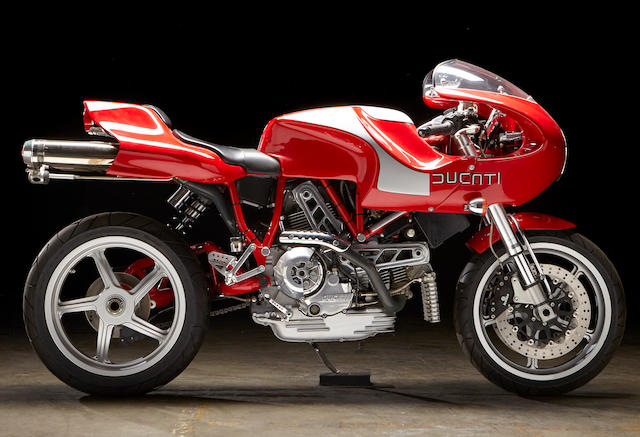Motorcycle Investor mag
Subscribe to our free email news
Ducati Mike Hailwood 900e
(by Ian Falloon, Mar 2022)

Falloon on
what may turn out to be Pierre Terblache's most
successful creation
I was fortunate to visit
Pierre Terblanche at Ducati when he had just presented
the prototype 900 MHe. Now this is one of most desirable
of modern Ducatis.
Pierre Terblanche’s concept
motorcycle, the Mike Hailwood Evoluzione of 1998, took
everyone by surprise and was the undoubted star of the
show. None were more surprised than the Italian press,
so often party to inside information at the factory.
“Over the summer I left
Bologna and completed this project in England,”
Terblanche says. “Ever since Mike Hailwood won at the
Isle of Man in 1978 I have wanted to build my own
interpretation of those magnificent NCR racers.”
Terblanche went to AKA design
in Hitchin, north of London. Here, over an eleven-week
period, he worked with a three-dimensional model on the
computer and constructed a full size clay model. The
idea behind the Evoluzione was to recreate the NCR
racers of the late 1970s.
While using an air-cooled
two-valve fuel injected 900 Supersport engine as a
basis, the engine was tidied externally through the use
of sump covers to hide the oil cooler and lines, with
the ignition coils on the camshaft bearing supports on
the cylinder heads. The engine had polished engine cases
reminiscent of the earlier “round-case” Ducatis, but
apart from the clutch was that of a standard 900
Supersport. The clutch was one of the more special
components on the bike. Weighing a mere 800 grams, it
was a slipper design with three plates and a diaphragm
spring by Poggipolini and Zornik.
The tubular steel frame was a
special construction by the Dutch company Troll, placing
the engine as far forward in the frame as possible while
retaining the same offset as the normal 900 Supersport
with a 23.5 degree steering head angle.
Though a twin shock swingarm
in the style of the original Hailwood Replica was
initially considered, this was discarded for a tubular
single-sided swingarm with Öhlins 125 Grand Prix shock
absorber, and modern 996 fork. The wheelbase is still a
very short 1420mm.
Wheels were Marvic, the rear
being 6.00 x 17 inches with a 200/50-17 inch tire. To
minimise unsprung weight a single 305mm disc was used at
the front. The disc was a product of Mislav Zornik and
constructed of Selcom, a carbon silesium combination.
Using only a single front
disc enabled the other brake calliper mount to be
machined off the fork and a single-sided stainless steel
bracket installed to locate the front mudguard.
Production versions however used twin discs.
One of the more advanced
features was the one-piece fairing and fuel tank.
Designed to keep as much weight on the front wheel as
possible, this unit was a nylon polymer, rotationally
moulded and heated while rotated.
The rear indicators were in
the exhausts, with gases exiting through a Super
Trapp-style exit. The Valeo headlight too was quite
small, being only 80mm in diameter. Other unique
features were the voice-activated ignition system and
television rear vision camera. Here were several other
features which didn‘t make it into production
The Mike Hailwood Evoluzione
also represented a new path for Ducati. As Terblanche
says, “This is really an extension of the Harley factory
custom idea. Here we take basically a standard bike and
alter it in such a way as to create a completely new
expression. My idea was to get away from complexity and
carbon-fibre. I also wanted to capture the feel of the
racing bike, that is why it is elemental, with very
clean lines.”
Pierre Terblanche breaks the
motorcycle into four distinct elements. The engine,
frame, wheels, and bodywork. “Thus it becomes a custom,”
he says, “and every component looks good.”
Ed’s note: The production
versions saw light from 2001 – see our
feature on the SportClassic range.
-------------------------------------------------
Produced by AllMoto abn 61 400 694 722
Privacy: we do not collect cookies or any other data.

Archives
Contact





